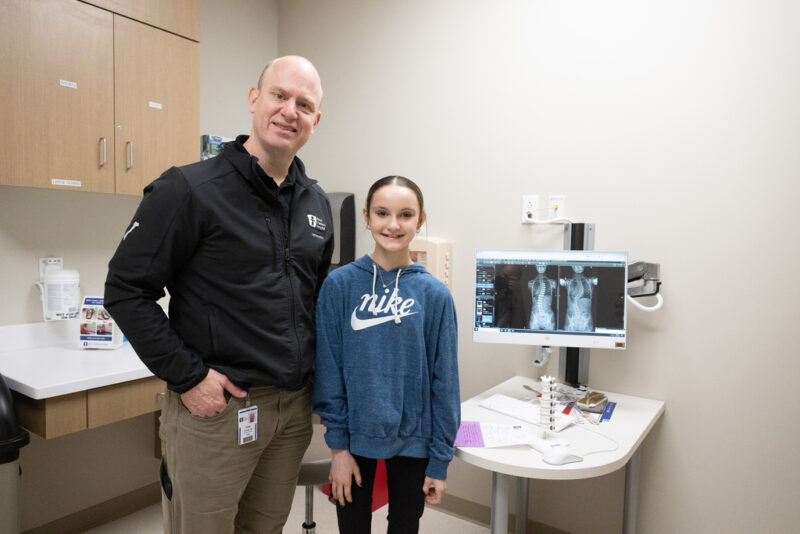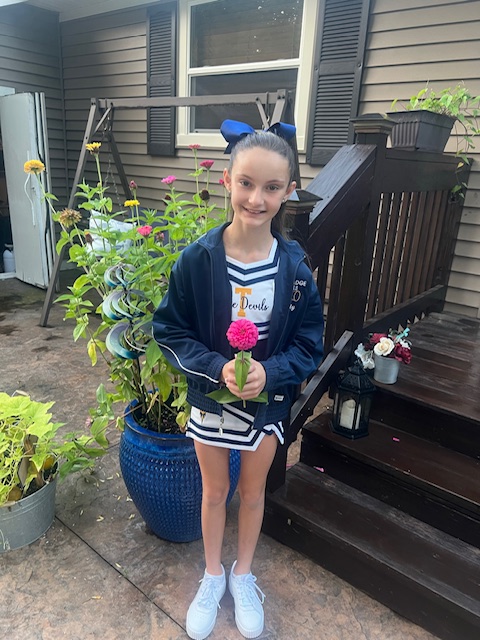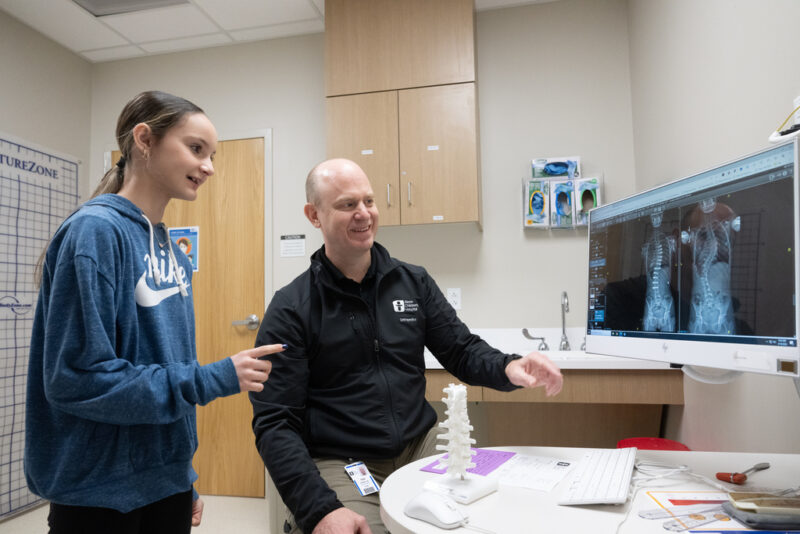
Mady and her spine surgeon Dr. Todd Ritzman. In Jan. 2024, Mady underwent vertebral body tethering (VBT) to treat her scoliosis.
Mady Sirlouis, age 11, is a bit of a frequent flier – adept at both back handsprings and trips to Akron Children’s for frequent broken bones.
“She breaks a bone every year,” said her mom, Autumn, “She’s broken both arms and both legs multiple times, but that doesn’t stop her from doing back flips and cartwheels while wearing a boot.
“One time she did 37 laps around the track to raise money for a charity while on crutches!” Autumn added.
In 2020, at age 8, Mady began experiencing tightness in her chest and would soon face a new challenge.
“She’s resilient and has a fairly high pain tolerance so when she complained I took her to the ER,” said Autumn. “It was there we found out she had scoliosis.”

Mady is active in cheerleading and gymnastics. Mady’s curve magnitude, flexibility and growth remaining made her a perfect candidate for VBT surgery which doesn’t fuse the spine or cause loss of motion.
The family was referred to orthopedic surgeon Dr. Todd Ritzman who diagnosed Mady with Juvenile Idiopathic Scoliosis. Although it isn’t known why some kids develop scoliosis, research shows it can run in families (Autumn also has scoliosis).
Dr. Ritzman prescribed a Boston brace constructed of a custom-fit lightweight plastic that Mady wore under her clothes. He also had her start taking Vitamin D because some studies suggest a correlation between Vitamin D deficiency and curve progression, especially in kids who are not done growing.
Mady also started Schroth physical therapy, a nonsurgical approach to idiopathic scoliosis that uses hands-on techniques to assist patients with active 3-dimensional curve corrections.
Despite trying these methods for almost 3 years, Mady’s curve continued to progress. Dr. Ritzman explained to the family that Mady was the perfect candidate for vertebral body tethering (VBT), also known as anterior vertebral tethering.

Dr. Ritzman shows Mady the before and after images of her spine.
“During vertebral body tethering, screws are placed through a minimally invasive thoracoscopic approach into the front of the spine,” said Dr. Ritzman. “These screws are then ‘tethered’ or connected with a polyethylene cord that enables both significant immediate scoliosis correction via tensioning of the cord and screws and continued scoliosis correction through growth modulation.”
Growth modulation occurs by the tether’s restriction of spinal growth on the long (convex) side of the spine curve while the short (concave) side of the spine has continued unrestricted growth.
“This type of surgery is ideal for patients who fail bracing (curve progresses despite attempting bracing) and who have significant growth remaining,” said Dr. Ritzman. “Mady’s curve magnitude, flexibility and growth remaining made her a perfect candidate.

Before surgery (L) and after surgery (R)
“VBT is a fusionless procedure which provides significant immediate correction. It then harnesses a patients’ growth to enable continued deformity progression through the adolescent growth spurt,” he added. “Ultimately, a smaller curve and straighter spine can be achieved without fusing and losing motion.”
In January 2024, Mady underwent surgery in Akron Children’s state of the art operating room dedicated solely to spinal surgeries.
“She went from a curve of 57 degrees on top and 59 degrees on the bottom to curves around 20 degrees,” said Autumn. “She also gained 1 ½ inches of height.”
With Mady’s passion for gymnastics, Autumn knew it was important that Mady didn’t lose the flexibility in her spine that would have resulted from the stiff metal rods needed for spinal fusion.
“She wants to be the next Simone Biles,” said Autumn. “She’s in cheer 4 days a week and does gymnastics at World Elite in Tallmadge.”
Although she had some restrictions immediately following surgery, Mady has been medically cleared for all activities. And more importantly, she has gained a newfound self-esteem she was lacking due to her scoliosis.
“Mady says the world looks different now because it’s straighter. She’s so proud of herself for going through this,” said Autumn. “She walks straighter, her T-shirts fit better and the pain in her chest is gone.”
Akron Children’s performs nearly 130 surgeries for idiopathic and other types of scoliosis each year.
“We have a dedicated pediatric spine team here as well as a dedicated spine operating room, built to perform safe and efficient pediatric spine surgeries,” said Dr. Ritzman.
Dr. Ritzman noted that Akron Children’s spine surgery outcome data is among the best in the American College of Surgeons National Surgical Quality Improvement Program for patient length of stay and with performance better than national benchmarks for factors such as complication rates and re-admissions.
Akron Children’s is committed to pediatric spine research with open studies and ongoing collaboration with other children’s hospitals to share best practices.
Learn more about scoliosis and explore the treatments offered at the Spine Center, an Akron Children’s Center of Excellence.











